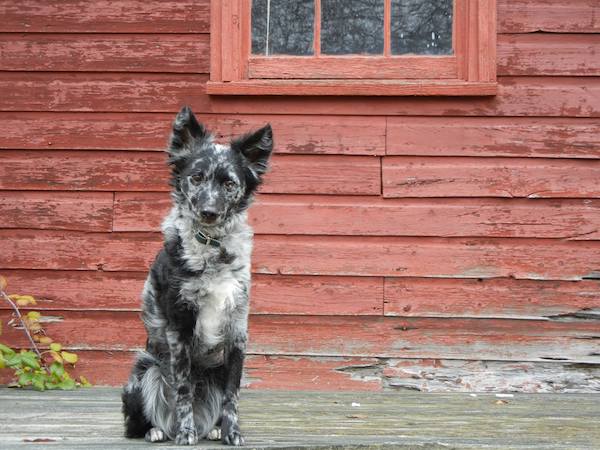
You just never know where a photo you send us will turn up, and we are grateful to Amanda Zepke Haldeman for sharing this lovely photograph of her Mudi, “Spring.” Spring was the source of a detail photo of her coat which we posted on Facebook and challenged readers to identify by breed.
“Spring” is a “cifra,” or black merle Mudi, and according to the AKC, hers is the only breed in the AKC herding group that has the merle color and healthy solid white colored dogs, too. The merle pattern may be present with any allowable color. Originally, we had thought that Spring was a blue merle, and found (incorrectly, on our part) what we thought was validation in a passage in the fabulous website, doggentics: Such dogs “are called blue merles because of the bluish color between the patches in their coat.”
The author accurately goes on to add that this widely-used term is actually misleading. “Technically they should be ‘black merles’. Their nose pigment is black and their eyes are brown or blue. They are able to make normal eumelanin in their coat, so their patches are black. If they didn’t have the merle gene, they would be solid black. “Blue merle” is misleading because it seems to say that these dogs have blue pigment (dd acting on black…when in fact they have black.”
In looking for interesting articles about the merle Mudi, we got sidetracked by a website that gushed, “The Mudi originated in Hungary and is a relatively new breed.” Hold us with restraints. The Mudi is hardly a new breed. In fact, some experts believe the Mudi just may be the oldest of the Hungarian sheepdogs. This just underscores the importance of checking a breed’s parent club and standard when seeking information about that breed.
Speaking of breed standards, we’re partial to the Canadian Kennel Club’s description of the Mudi’s “noggin.” It reads, “The most striking part of the Mudi is undoubtedly his head. To the observer it should give the impression of an alert, always energetic, cheerful and intelligent animal without any trace of timidity or aggressiveness.” Looking at the picture of Spring, we think she illustrates this quite nicely.
For those interested in the coat genetics of this breed, you may find this article interesting, and here’s a piece that appeared here a little while back.

In the AKC the Mudi is recorded or registered by its base color which in this case is black, and merle is added as a marking. So in the US this color of Mudi is known as a black merle.
Thanks, Mary, making the adjustment now!